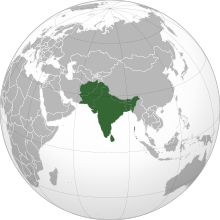This article needs to be updated. (May 2021) |
| COVID-19 pandemic in South Asia | |
|---|---|
 South Asia | |
| Disease | COVID-19 |
| Virus strain | SARS-CoV-2 |
| Location | South Asia |
| First outbreak | Wuhan, Hubei, China[1] |
| Index case | Kathmandu, Nepal |
| Arrival date | 5 January 2020 |
| Confirmed cases | 8,395,617 (17 February 2021) |
| Active cases | 1,176,416 (17 February 2021) |
| Recovered | 7,347,826 (17 February 2021) |
Deaths | 128,625 (17 February 2021) |
Territories | |
| Government website | |
| SAARC Disaster Management Centre | |
Countries and territories in South Asia have been affected by the COVID-19 pandemic. The first South Asian country to report a confirmed case was Nepal, which documented its first case on 23 January 2020, in a man who had returned from Wuhan on 9 January.[2] As of 2 July, at least one case of COVID-19 has been reported in every country in South Asia. Afghanistan, Bangladesh, Pakistan and Maldives have implemented lockdowns, Sri Lanka has responded with quarantine curfews while India and Nepal have declared a country-wide lockdown. Countries have also instituted various levels of restrictions on international travel, some countries have completely sealed off their land borders and grounded most international flights.
India, Pakistan, and Bangladesh were three South Asian countries that overtook China in terms of the number of coronavirus cases. In the middle of May, India was the first South Asian country to overtake China in terms of the number of coronavirus cases. On 4 June, Pakistan was the second South Asian country. And on 13 June, Bangladesh was the third South Asian country. In India, the number of recoveries exceeded the number of active cases on 10 June. In Pakistan, the number of recoveries exceeded the number of active cases on 3 July. And in Bangladesh, the number of recoveries exceeded the number of active cases on 12 July.
Governments are attempting to coordinate a response to the pandemic through the regional organization, SAARC, the South Asia Association for Regional Cooperation. India Prime Minister Narendra Modi proposed a joint emergency fund to tackle the pandemic, and pledged to seed US$10 Million. As of 11 April, Sri Lanka had contributed US$5 million to the SAARC COVID-19 Emergency Fund and Pakistan $3 million, Bangladesh $1.5 million, Afghanistan and Nepal had given $1 million each, Maldives had given $200,000 while Bhutan $100,000.
- ^ Sheikh, Knvul; Rabin, Roni Caryn (10 March 2020). "The Coronavirus: What Scientists Have Learned So Far". The New York Times. Retrieved 24 March 2020.
- ^ Cite error: The named reference
:1was invoked but never defined (see the help page).